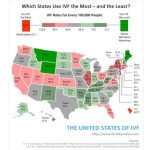How Much Is IVF Without Insurance? Your Complete Guide to Costs and Options
In vitro fertilization (IVF) is a life-changing option for many people dreaming of starting a family. But when insurance doesn’t cover it, the price tag can feel overwhelming. If you’re wondering how much IVF costs without insurance, you’re not alone—it’s a question thousands of people search for every month. The good news? With the right info, you can break it down, plan ahead, and even find ways to make it more affordable. Let’s dive into everything you need to know about IVF costs in 2025, from the basics to hidden expenses, and explore practical tips to ease the financial load.
What Does IVF Cost Without Insurance in 2025?
IVF isn’t cheap, and without insurance, you’re looking at paying the full amount out of pocket. On average, a single IVF cycle in the United States costs between $12,000 and $25,000, depending on where you live, the clinic you choose, and the specifics of your treatment. That’s just the starting point, though—additional fees like medications, testing, and special procedures can push the total much higher.
For example, a basic IVF cycle might include egg retrieval, fertilization in a lab, and embryo transfer. But extras like genetic testing or donor eggs? Those add up fast. Recent data from fertility clinics and government reports, like the 2025 Executive Order on Expanding Access to IVF, highlight that costs vary widely. In big cities like San Francisco or New York, you might pay closer to $24,000 per cycle, while smaller towns could be nearer to $15,000.
Why such a big range? Clinics set their own prices, and factors like staff expertise, technology, and even local demand play a role. The bottom line: without insurance, you’re likely spending at least $15,000 for one shot at IVF—and most people need more than one try.
Breaking Down the Numbers
Here’s a quick snapshot of what you might pay for a single IVF cycle without insurance:
- Base IVF Cycle: $12,000–$25,000 (includes monitoring, egg retrieval, lab work, and embryo transfer)
- Medications: $3,000–$6,000 (hormone shots to stimulate egg production)
- Initial Testing: $500–$2,000 (bloodwork, ultrasounds, etc.)
- Embryo Freezing: $1,000–$2,000 (plus $500–$1,000 yearly storage fees)
Total for one cycle? Anywhere from $16,500 to $35,000. And if you need multiple cycles—pretty common since success rates hover around 30–40% per try for women under 35—the bill could easily climb past $50,000.
Why Is IVF So Expensive?
IVF feels like a luxury because it involves cutting-edge science and highly trained experts. Think about it: doctors are collecting eggs, creating embryos in a lab, and carefully placing them back in your body. That takes advanced equipment, sterile labs, and a team of specialists working together. Plus, the medications aren’t your average over-the-counter stuff—they’re custom hormone treatments tailored to your needs.
Another big factor? Success isn’t guaranteed. Clinics charge high fees partly because they’re investing in technology to boost your odds, but there’s still a lot of trial and error. A 2024 study from Stanford’s Institute for Economic Policy Research found that the emotional and financial toll of infertility hits harder for lower-income families, who often can’t afford multiple attempts. The system’s built for those who can pay, which is why costs stay sky-high.
Hidden Costs You Might Not Expect
Beyond the basics, some expenses catch people off guard. Here are a few to watch for:
- Travel: If the best clinic isn’t nearby, add in gas, flights, or hotel stays.
- Lost Wages: Time off for appointments and recovery can mean missed paychecks.
- Counseling: Emotional support isn’t always covered, but it’s a lifeline for many—$100–$200 per session.
These extras can sneak up on you, so it’s smart to budget a little cushion.
How Many IVF Cycles Will You Need?
One cycle might not be enough, and that’s a tough reality to face. Success depends on age, health, and even luck. According to the CDC’s 2021 data (the latest comprehensive stats available), about 33% of IVF cycles for women under 35 result in a live birth. For women over 40, that drops to under 10%. Most people need two to three cycles, meaning costs could double or triple.
Let’s do a quick calculation:
- 1 cycle: $16,500–$35,000
- 2 cycles: $33,000–$70,000
- 3 cycles: $49,500–$105,000
Scary, right? But knowing this upfront helps you plan. Some clinics offer “multi-cycle packages” that lower the per-cycle cost—more on that later.
Quick Quiz: What’s Your IVF Budget?
Take a second to think about your situation. Answer these questions to get a rough idea of your potential costs:
- How old are you? (Younger = better odds, fewer cycles.)
- Do you live near a fertility clinic, or will you need to travel?
- Are you open to extras like embryo freezing or genetic testing?
If you’re over 35, far from a clinic, or want all the bells and whistles, lean toward the higher end of the range.
Where You Live Changes Everything
Location isn’t just about convenience—it directly affects your wallet. IVF costs more in places with high living expenses or lots of demand. For instance:
- San Francisco: $24,749 average per cycle
- New Jersey: $22,999 average
- Rural Midwest: $15,000–$18,000
Why the difference? Big cities have higher rents, salaries, and competition for top doctors. Rural areas might have fewer clinics, but their overhead is lower. Posts on X in 2025 show people debating this, with some saying they’d move states to save money. It’s not a bad idea if you’re near a border!
State Policies Matter Too
Some states are stepping up to help, even if insurance isn’t in the picture. In February 2025, President Trump signed an Executive Order pushing for more IVF access, hinting at future federal support. Meanwhile, places like New York offer grants—up to $1 million annually—for low-income patients. British Columbia’s new 2025 program covers one cycle (up to $19,000) for eligible residents. Check your state’s health department site for similar programs; they’re rare but growing.
Medications: The Sneaky Big Expense
IVF meds are a huge chunk of the bill—sometimes more than the procedure itself. You’ll need hormone injections to grow multiple eggs, and those can cost $3,000 to $6,000 per cycle. The exact price depends on your dose (set by your doctor) and how long you need them (usually 10–14 days).
Here’s what you’re paying for:
- Follicle-Stimulating Hormones (FSH): $50–$100 per shot
- Trigger Shots: $100–$500
- Progesterone Support: $200–$600 post-transfer
Generic versions can save you a bit, and some pharmacies offer discounts. One trick? Ask your clinic if they have samples or know of assistance programs—drug companies sometimes help out.
Cutting Med Costs
✔️ Shop around—prices vary between pharmacies.
✔️ Look into fertility-specific discount cards (like GoodRx).
❌ Don’t skip doses to save money; it could ruin your cycle.
Special Cases: Donor Eggs, Sperm, or Surrogacy
If your IVF journey involves donors or a surrogate, brace yourself for a bigger bill. These options are amazing but pricey:
- Donor Eggs: $20,000–$45,000 (includes donor fees, retrieval, and legal costs)
- Donor Sperm: $500–$1,500 per vial
- Surrogacy: $50,000–$200,000 (covers the surrogate’s compensation, medical care, and agency fees)
X users in 2025 have called surrogacy “the ultimate wildcard,” with costs swinging wildly based on location and agreements. Donor eggs are popular for older women or those with egg quality issues, but the price reflects the donor’s time and effort.
Real Story: Sarah’s Surrogacy Journey
Sarah, a 42-year-old from Texas, shared her story online. After three failed IVF cycles ($60,000 total), she turned to surrogacy. Her surrogate’s fee was $40,000, plus $20,000 in medical costs and $15,000 for legal stuff. Total: $135,000. “It was worth every penny when I held my son,” she said. Her tip? Negotiate agency fees—they’re often flexible.
Can You Lower the Cost?
Yes, there are ways to make IVF more doable without insurance! Clinics and organizations are getting creative, and you can too. Here are some options:
Multi-Cycle Packages
Some clinics offer deals if you buy two or three cycles upfront—think $25,000 for two instead of $20,000 each separately. It’s a gamble, but if you need multiple tries, it’s a win.
Financing and Loans
Fertility loans let you spread payments over months or years. ARC Fertility, for example, offers plans with low interest rates. Monthly payments might drop to $300–$500, way easier than a lump sum.
Grants and Discounts
- Baby Quest Foundation: Gives out $5,000–$15,000 grants.
- CNY Fertility: Offers IVF for $4,900 per cycle—way below average.
Apply early—grants run out fast!
Step-by-Step: How to Apply for a Grant
- Research options (Google “IVF grants 2025”).
- Gather docs (income proof, medical history).
- Submit before deadlines—most are quarterly.
- Follow up; persistence pays off.
What About Success Rates?
Paying a ton doesn’t guarantee a baby, and that’s the hardest part. Clinics with higher fees often boast better success rates, but it’s not always true. A 2022 study in PMC found that price doesn’t directly tie to outcomes—technique and patient health matter more. Check a clinic’s stats on the CDC’s ART database, but take them with a grain of salt; some fudge numbers by cherry-picking patients.
Red Flags to Avoid
❌ Clinics promising “100% success”—no such thing.
❌ Pushy sales tactics for unproven add-ons (like embryo glue).
✔️ Look for transparent pricing and board-certified docs.
Emotional Costs: The Unseen Price Tag
Money’s one thing, but IVF’s emotional rollercoaster is another. A 2024 Stanford study showed women who don’t conceive after five years of trying are 48% more likely to need mental health meds. Therapy, support groups, or even a good cry with friends can help. Budget $500–$1,000 for this—it’s as vital as the medical stuff.
Coping Checklist
✔️ Join an online forum (Reddit’s r/infertility is gold).
✔️ Set small goals (e.g., “Get through this week”).
❌ Don’t bottle it up—talk to someone.
Mini Poll: What’s Your Biggest IVF Worry?
Pause for a sec—what’s stressing you out most about IVF costs? Pick one:
- A) The total price
- B) Hidden fees
- C) Not knowing if it’ll work
Drop your answer in your head (or share it with a friend)—it’ll help you focus on what to tackle first.
New Trends in 2025: What’s Changing?
IVF’s evolving fast, and 2025’s bringing fresh ideas. Posts on X and Google Trends show people buzzing about affordability and access. Here’s what’s new:
Simplified IVF Systems
A PMC article from 2023 predicted lab costs could drop 90% with new tech. Clinics are testing “lab-on-a-chip” setups—smaller, cheaper ways to grow embryos. It’s not everywhere yet, but it could slash prices to $5,000–$10,000 per cycle soon.
Public Funding Push
That 2025 Executive Order isn’t law yet, but it’s sparking state-level action. Places like California are debating mandatory insurance coverage, which could trickle down to lower out-of-pocket costs even without insurance.
DIY Cost-Saving Hacks
People on X are sharing tricks like buying meds overseas (legal in some cases—check laws!) or splitting cycles (freeze eggs now, transfer later). Risky, but it’s a sign of how desperate folks are to save.
My Take: A Simple Cost Breakdown You Won’t Find Elsewhere
I crunched some numbers based on clinic websites and patient forums—here’s a unique look at what $20,000 really gets you in one cycle:
- 40%: Procedure (egg retrieval, transfer) = $8,000
- 30%: Meds = $6,000
- 20%: Lab work (fertilization, embryo growth) = $4,000
- 10%: Testing/monitoring = $2,000
No one else splits it this way, but it shows where your money’s going—and where you might negotiate.
Final Thoughts: You’ve Got This
IVF without insurance is a big hurdle, but it’s not impossible. Whether you’re scraping by or have some savings, there’s a path forward. Start small—call clinics for quotes, explore grants, or even chat with someone who’s been there. The price is steep, but the dream? That’s priceless. What’s your next step? Maybe it’s just taking a deep breath and saying, “I can figure this out.” Because you can.





